|
<< Click to Display Table of Contents >> Purchase Orders |
  
|
|
<< Click to Display Table of Contents >> Purchase Orders |
  
|
•Purchase Orders
Allows creation and processing of Purchase Orders.

- Manage Purchase Orders
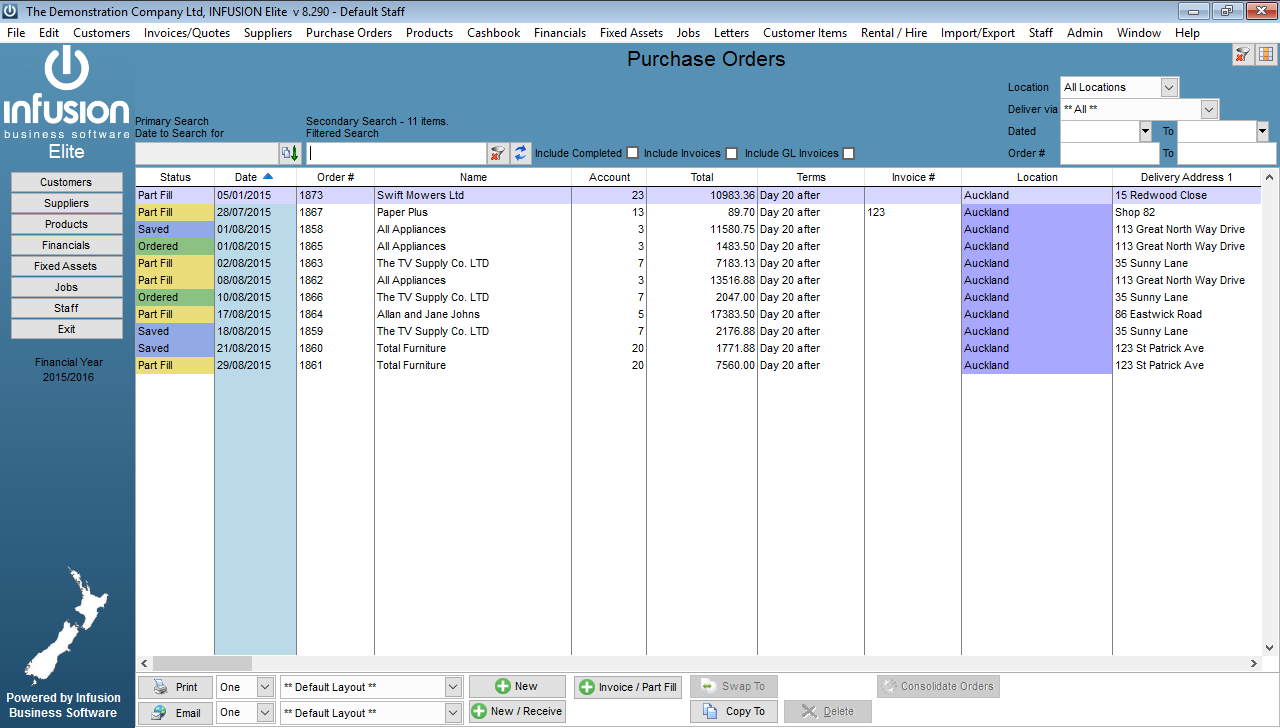
The Manage Purchase Orders screen provides a central point to create, receive and review Purchase Orders.
By default, the screen will display all current orders which have been Ordered, Saved, Part Filled, or All Received.
Selecting Include Completed will display all Purchase Orders including those that have been fully receipted.
Selecting Include Invoices will display the Invoices received for each of the Purchase Orders.

Selecting the Include GL Invoices will display the invoices loaded against a Supplier without Products - these are identified as Invoice-GL.

The controls for the Manage Purchase Orders screen are located at the bottom of the screen.

The Print or Email buttons can be set to carry the action out for One or All of the Purchase Orders displayed on the list.
- New Purchase Order
There are different options to create a new Purchase Order:
1)From the Purchase Orders menu / New Purchase Order
2)Using the shortcut Ctr+O
3)Using the buttons New or New / Receive at the bottom of the screen
The New option will prompt you to create a new order.
If you need to create a Purchase Order and receive the stock at the same time, selecting the New / Receive option will allow this to be done in one step, including the receipt of the Supplier’s invoice if needed.
If the Purchase Order has already been part filled or supplied use the Invoice / Part Fill to process the Invoice for the partial receipt.
If you have created a Purchase Order for one supplier, but they can’t supply the products, then you can use Swap To. This will allow the Order to be moved to an alternative Supplier. This option is only available on Purchase Orders that have been Saved or Ordered.
Selecting the Copy To will allow you to replicate an Order to another Supplier.

Using the Consolidate Orders option will allow all Saved orders for the same Supplier to be combined into one order.
When starting a new Purchase Order, the Supplier will be required. If there are Saved Purchase Orders against this Supplier (i.e. not yet Ordered), a list of these will be shown. These can be selected and recalled using the Recall button or a new Purchase Order created by selecting New.

If the software is setup for creation of multiple types or Purchase Orders, a pop up box will appear requiring selection of a type. These types are setup under the Admin / Defaults menu and may include as options: Standard Order, Multi Location, Customer Special or Job Management Order. Select the required Purchase Order type, then click OK.

The Multi Location option will be available if you have multiple Locations set up under Admin / Settings / Products / Manage Locations and Admin / Defaults / Manage supplier Defaults / Orders / Allow Multi Location Ordering. This option allows for a Purchase Order to be raised on a single Supplier that will be receipted into multiple locations.
The Customer Special option will be available if set in Admin / Defaults / Manage supplier Defaults / Orders / Allow Invoicing Direct to Customer. Selecting a Customer under the Customer tab is part of the Invoice entry requirements. A Pending Invoice will be created for the Customer when the Product(s) is receipted in.
The Job Management option will be available if the Job Management module is installed (Elite package only). This type of Purchase Order will assign a cost to the associated Job when the Product is receipted in. If a Supplier Invoice relating to the Purchase Order has a different value on it than a Packing Slip the costs on the Job will be updated when the Invoice is processed.
The Standard Order option won’t be available if the option Admin / Defaults / Manage supplier Defaults / Orders / Require Job ID on all Orders is selected.
Purchase Order screen
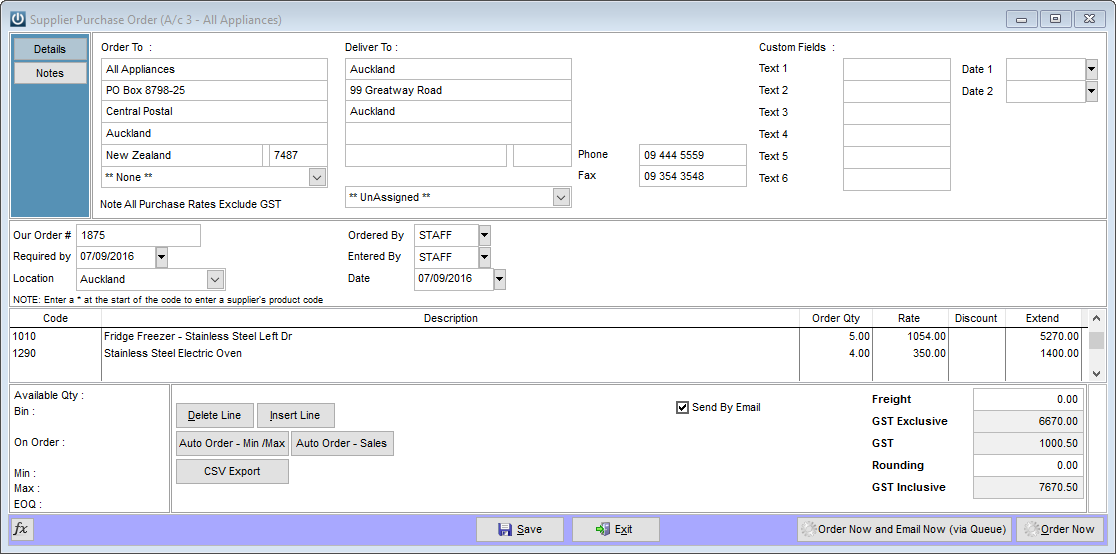
Details Tab
The header of the Purchase Order will contain the Supplier details, your requested delivery address and the Custom fields.
A new Our Order# will automatically be generated for each order. This can be overwritten if allowed under Manage Suppliers Defaults / Preferences.
The Required by Date is the date the Products are required.
If there are multiple locations, a Location the goods are to be receipted in to can be set. Changing this will change the delivery address details in the Deliver To field to that of the corresponding Location.
The Ordered By field is for entry of a staff member name.
The Entered By is the staff member who processed the Purchase Order.
The Date field is the date the Order was raised. All Ageing and BalancesBalances will be updated using this date.
Notes Tab
Allows for entry of notes relating to the Purchase Order as well as Custom Text.

Customer Tab
This will only be present if it is a Customer specific order. It allows entry of the Customer’s details – to be used when Product is receipted in and a Pending Invoice is created.

To enter Product onto a Purchase Order either:
1)type the Code of the Product into the Code field
2)select F9 when in the Code field
3)scan or type the barcode of the Product into the Code field
4)typing an “*” then the Supplier’s code (set up under the Product)
Selecting the Function Key List will display all of the Function Keys and Special Codes available to be used when entering in data into the Purchase Order screen.
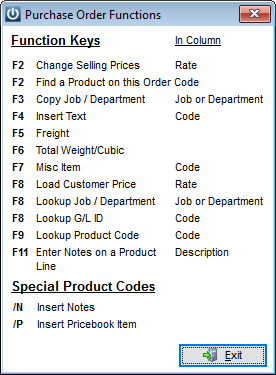
An item from a Pricebook can be entered onto the Order by typing in /P into the Code field. Only Pricebooks for the Supplier on the Purchase Order will be available to be selected to find the Product being ordered. If the Pricebook item has been associated with a current Product Code (see the Products Help manual for this) the current Product Code will be used on the Order when Order Now is selected. If this hasn’t been set, then a pop up window will display indicating that a new Product Code is going to be set up for the Pricebook item. By default, the new Code will be the same as the Pricebook code but this can be changed.

If the Product has been setup to Stop All Sales,Stop All Sales a message will pop up stating so. The Product cannot be Purchased if this is the case.
The product information box at the bottom left of the screen will display the current stock holding for the Product code, along with the Bin Location Min and max levels and the EOQ

The Auto Order – Min/ Max Auto Order button allows creation of a Purchase Order for all Product that can be bought from the selected Supplier. Only Suppliers setup against the Product under the Supplier tab will be evaluated for ordering. The Minimum and Maximum levels setup against the Product under the Locations tab dictate whether and how many of each Product will be ordered. If the quantity of Product in stock is less than the Location Minimum then an order will be created. The amount ordered will be a quantity that will bring the stock holding up to the Location Maximum.
The Auto Order – Sales button allows the creation of a Purchase Order for all Products that can be bought from the selected Supplier. The order can be calculated for all or a range of Products set against the selected Supplier, based on the quantity sold over a selected date range or based on yearly sales.

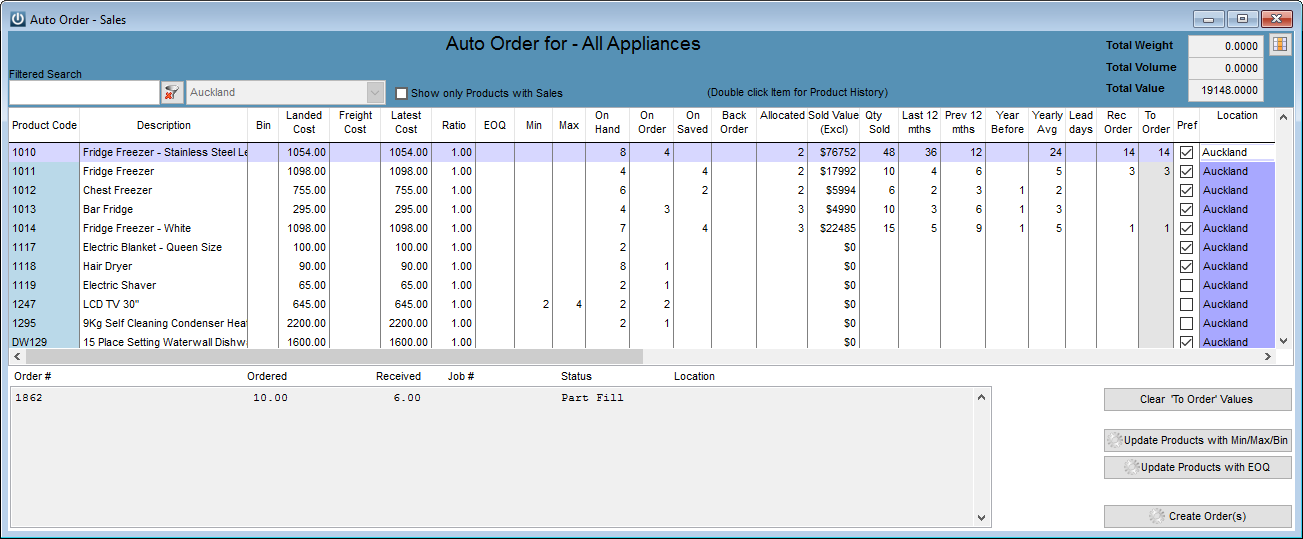
The Auto Order – Sales screen contains a lot of information: Product Code, Description, Bin Location, along with Landed Cost, Freight Cost and Latest Cost are followed by the product Ratio, EOQ, Min and Max Product Holdings. The On Hand, On Order, Back Order and Allocated quantities are then displayed. The next section displays the total net sales in Sold Value and the total Qty Sold as well as the quantities per year for the past three years (Last 12 mths, Prev 12 mths and Year Before). This is followed by the Yearly Average, the Lead Time for this product line, and the Received Orders. Finally, the system produces a figure which it considers is the recommended quantity To Order. The information is displayed per Location.
The quantity to order can be changed in the To Order field.
The top right of the screen will display the total weight, volume and value of the order. This information is very useful for managing shipping containers versus Product ordered.

The bottom left of the screen will display information if a highlighted item is already on a Purchase Order.

By double clicking on any of the Product lines on this order screen you will be able to see the Sales History for the three years.
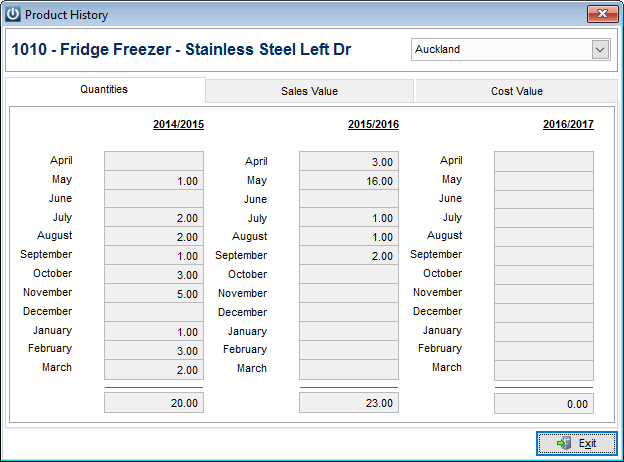
The Fields icon at the top right corner of the Auto-Order Sales screen shows the columns available to be displayed on the screen. Select / deselect options as required to customize the screen per user. The Save button will retain these settings for the next time the user opens the screen.

It is also possible to export the order to Excel from there.

The bottom right corner of the screen provides a number of options
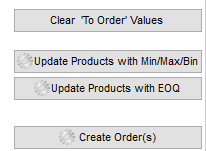
1)Clear ‘To Order’ Values allows clearing all of the quantities in that field
2)Information manually entered in the Bin, Min and Max fields of this screen can be saved on the Product record by using the Update Products with Min/Max/Bin option.
3)Information manually entered in the EOQ (Economic Order Quantity) field of this screen can be saved on the Product record by using the Update Products with EOQ.
4)Create Order(s) will bring all the details back onto the Purchase Order screen, ready to review and send to your Supplier.
Selecting the Save button saves the Purchase Order as Pending. This can be viewed by selecting the Pending Purchase Orders or Create Purchase Order from the Suppliers drop down menu then choosing the same Supplier.
Selecting the Order Now and Email Now (via Queue)Order Now button:
1)processes the Purchase Order
2)updates Product and Supplier information
3)automatically emails the Purchase Order to the Supplier leaving a log in the Email Queue, without having to open the Queue later to send.
This button is enabled if the Supplier has an email link set for Purchase Orders, the Send by Email tick box is not tuned off on the order and the user logged in has the option ‘Allow Email Now’ option enabled in the Staff record’s Login tab under Staff / Manage Staff.
Selecting the Order Now button processes the Purchase Order and updates Product and Supplier information. This will also create an email in the Email Queue so it can be sent later to the Supplier (if the Supplier has email link set for Purchase Orders the Send by Email tick box is not tuned off on the order). A prompt to print the Purchase Order will appear. Select a “Grouped By” print layout to have the Location the Product is to be delivered to displayed on the Purchase Order.
Returning Goods to a Supplier
The same process for creating a Purchase Order should be used when returning goods but instead using negative value quantities.
Use the notes field to add additional information as to the reason for the return.
The Order should then be Ordered, rather than Saved. This will then reduce the available quantity to sell and record against the Supplier’s account that you have a pending credit.

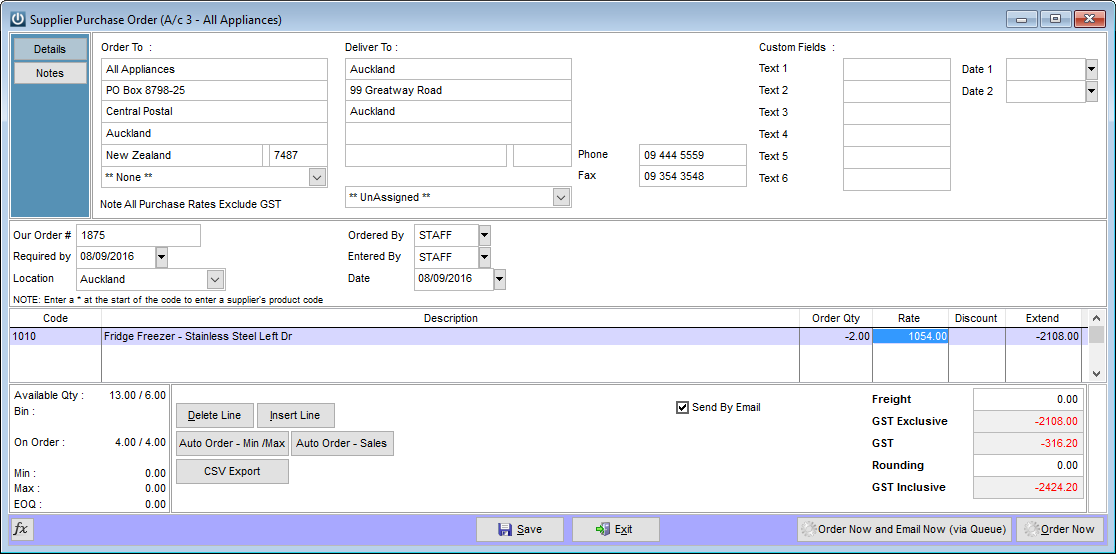
Due to the negative value of the Purchase Order the header text will automatically change to a Credit Request.

Purchase Orders Right Click Menu

Right clicking on a transaction will give you the options to View Audit (this option is not available for Saved Purchase Orders), Print/Preview, Email, Open Supplier to make changes, or open the Supplier Enquiry screen.
To Receive Products(From Order)
From the Manage Purchase Orders screen locate the desired order and double click to open.

You will now be given the option to receipt the goods in with or without an Invoice. The permissions to do this are set up against each Staff member under their Login tab for their account.
Selecting No will mean the goods can be to be receipted in with a Packing Slip. The Purchase Order will then change status to Part Fill or All Received.
Receiving with No Supplier Invoice (Packing Slip)

The system will require a Packing Slip Number to be supplied, then in the Received field enter the quantity of each line item received. If the order has been received in full then you can select Receive All from the bottom of the screen.

Once the Line items have been updated select Process.
Select the Print Labels option to print labels when receipting in goods.
For a Job Management order with a Product assigned to a Job, highlighting the line will display the Job Title, Description and Customer in red.
If this is a multi-location Purchase Order, ensure Product is being receipted into the correct location.
Make alterations to the RateRate if required.
Functionality from the Function Key List includes:
Selecting the F11 key when in the Supplied field allows a specified number of labels to be scheduled for the Product selected.
Selecting the F12 key will allow apportioning of Freight costs over the Products on the Purchase Order. Note: This can be done when processing the Packing Slip or Supplier Invoice.

These costs will not affect the value of the Packing Slip or Invoice. Use the Fixed Amount option to allocate a fixed Freight Cost per unit on the order. The Split Amount option will split a known Freight Cost over all units on the Order. Alternatively, a Freight Cost can manually be entered for each item. A calculator is available to help with this. Selecting the Update button will update the Latest Shipping Cost for the Products.
If the order has not been fully received, it will display in the Manage Purchase Orders screen as Part Filled.
When the rest of the order arrives on a subsequent Packing Slip the process must be repeated for the remaining items.

The Processed column now shows the quantities previously processed. The next Packing Slip quantities will be entered into the Receive column.

The Status of the order has now changed to All Received indicating that all the goods have been supplied, but the Invoice has not yet been processed.
![]()
When the Supplier’s Invoice arrives, locate the order in the Manage Purchase Orders screen and double click.
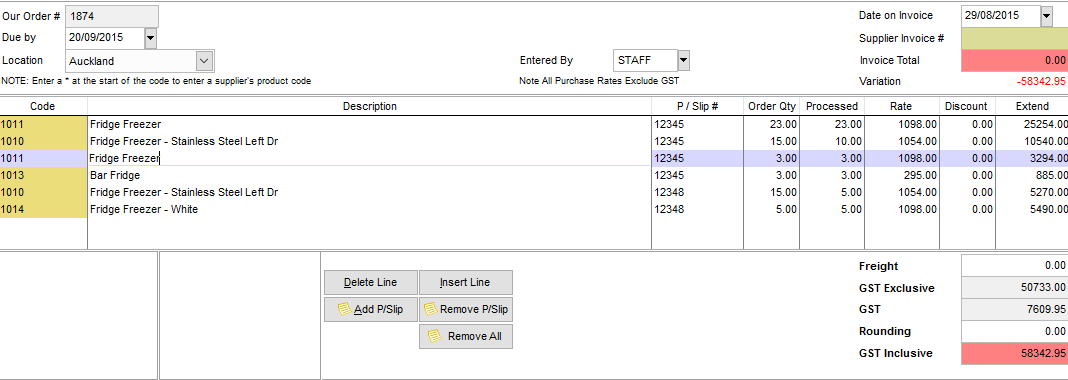
The system will now open up the Supplier Invoice screen and automatically add the receipted Packing Slips that relate to this order to the invoice.
The Supplier Invoice Number is a required field; the Invoice can’t be processed without it.
The Invoice Total field needs to be manually entered - this ensures that the line items entered balance and agree with the Invoice supplied. Any variation will display in Red until the lines or total are corrected.
As the goods have come from several packing slips the packing slip number is displayed in the body of the Invoice
Once the Invoice balances and the Supplier’s Invoice number has been entered the Invoice will be able to be processed.
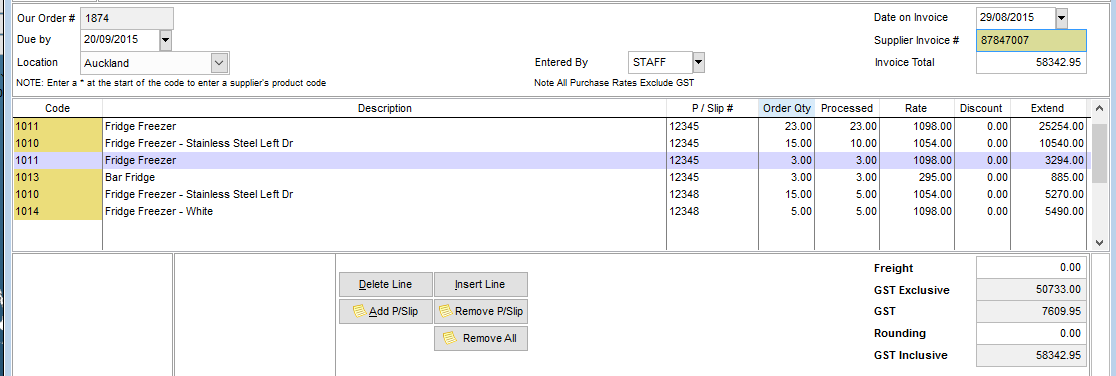
Deferred Payment Terms can be entered at this point.

Selecting the Deferred Payment from the top left of the screen will allow you to manually set the date and amount of each payment for this invoice. If the invoice is to be split evenly over a number of months, use Split Balance option. Enter the date of the first payment and then the number of months.

The system will then calculate the payments and then their due date.

Once the Supplier Invoice has been processed, an enquiry on the Supplier account will show the Invoice outstanding as followed.
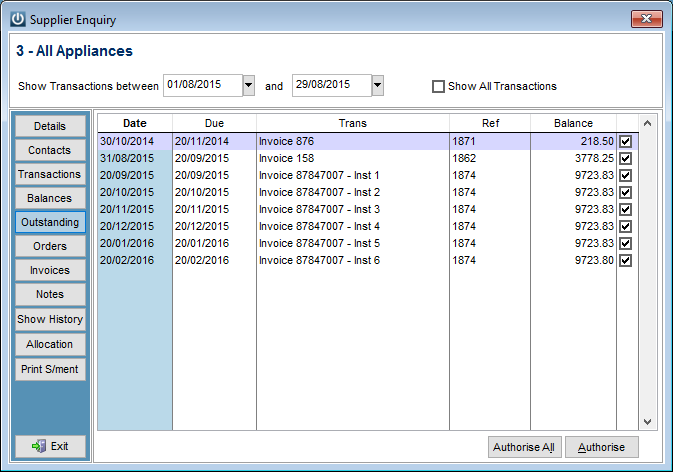
These values will show as deferred on the Suppliers ATB reports until they become due.
Reports
